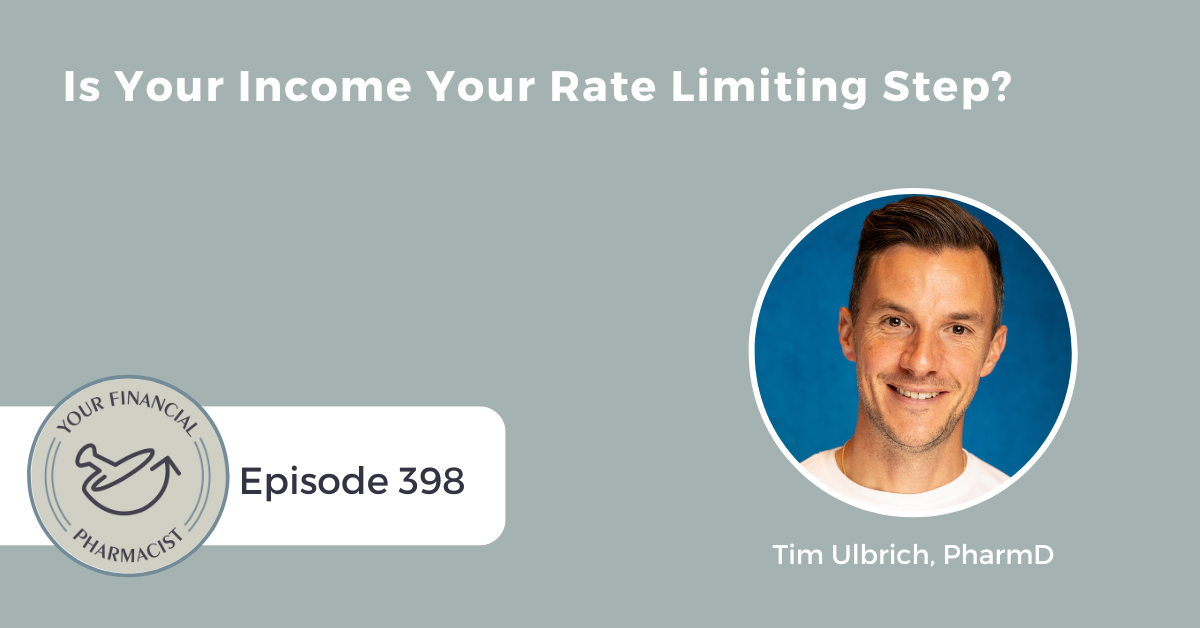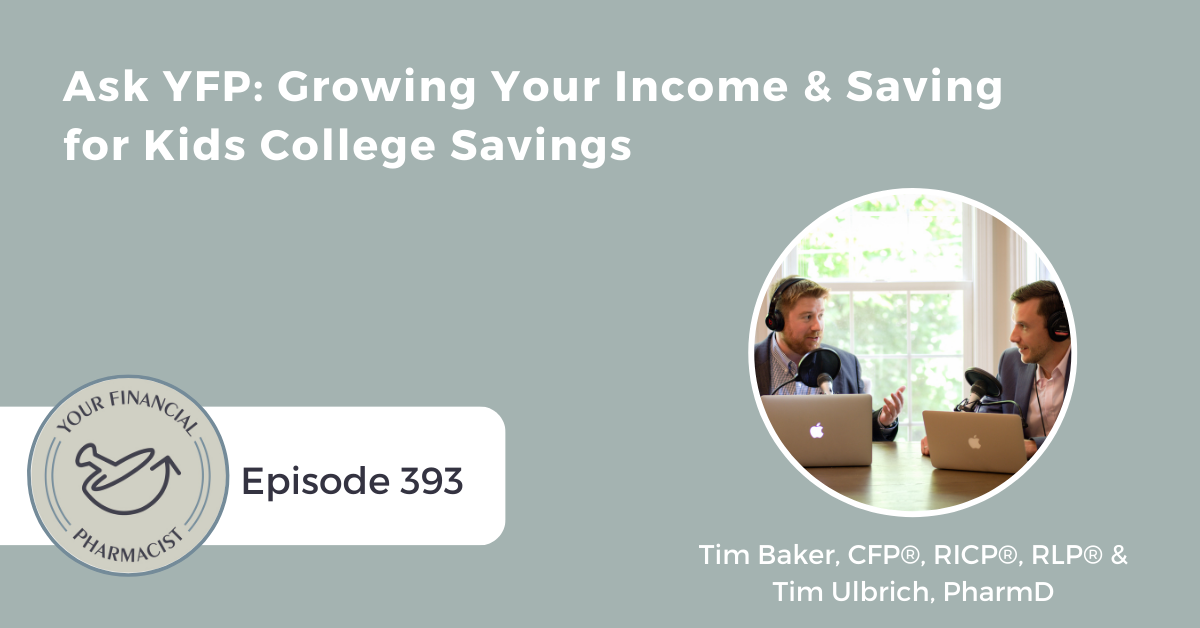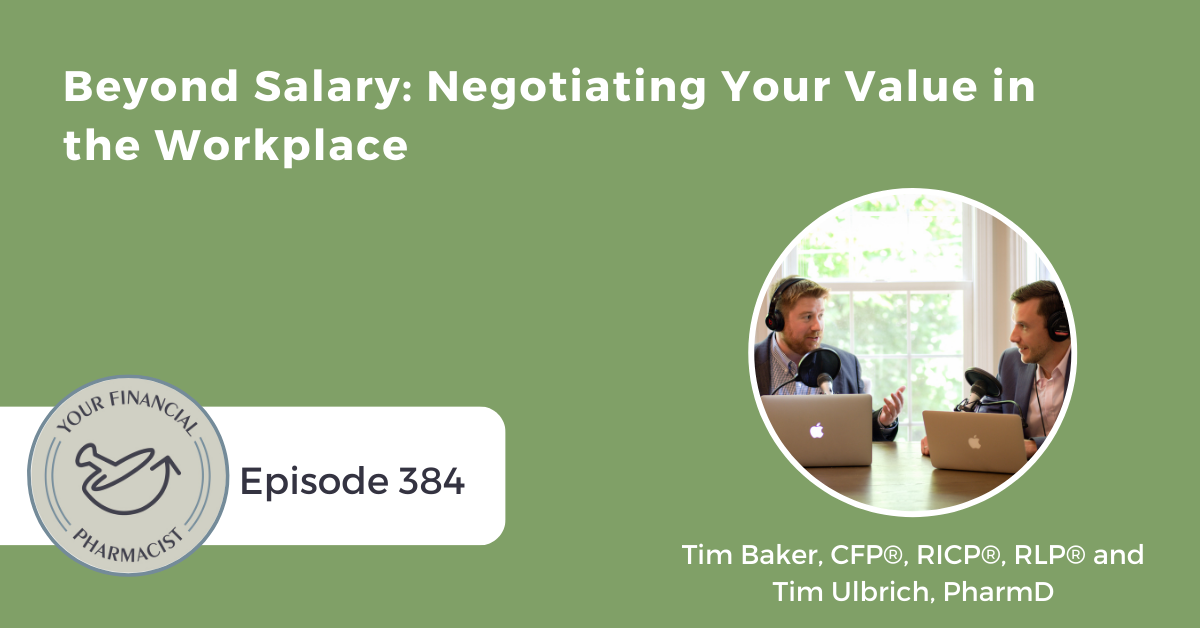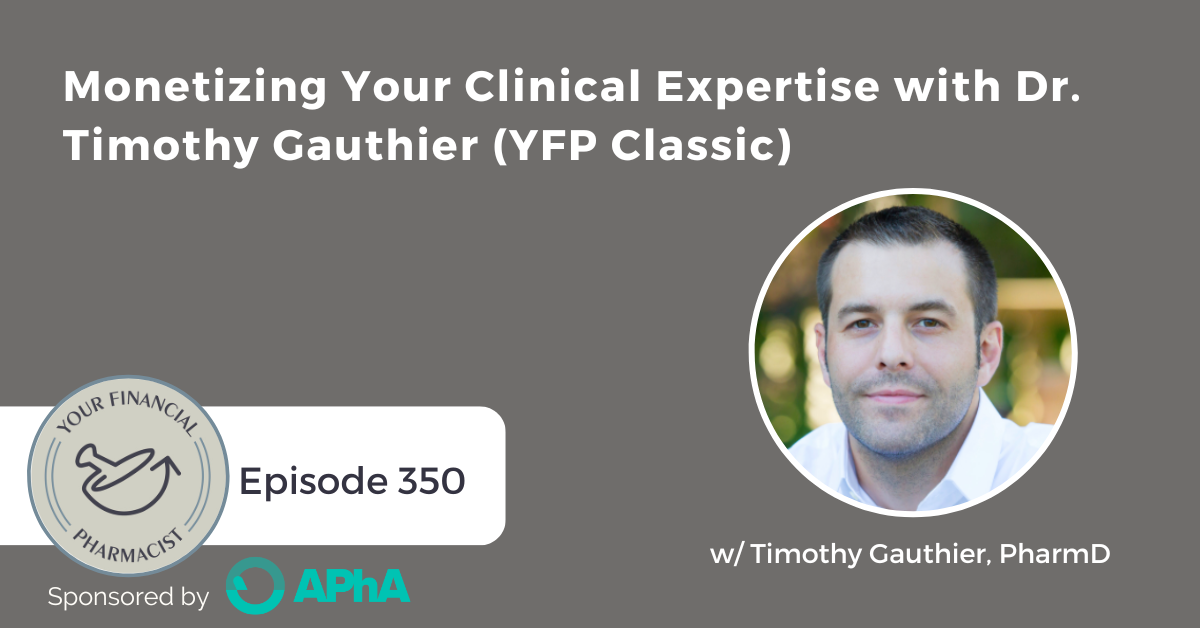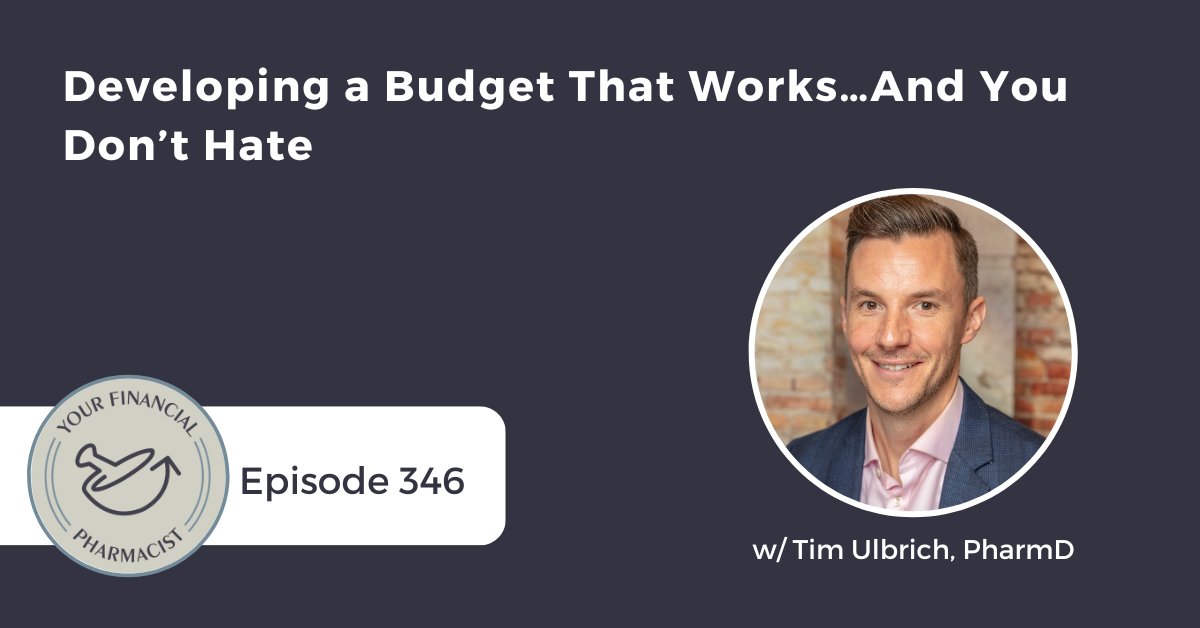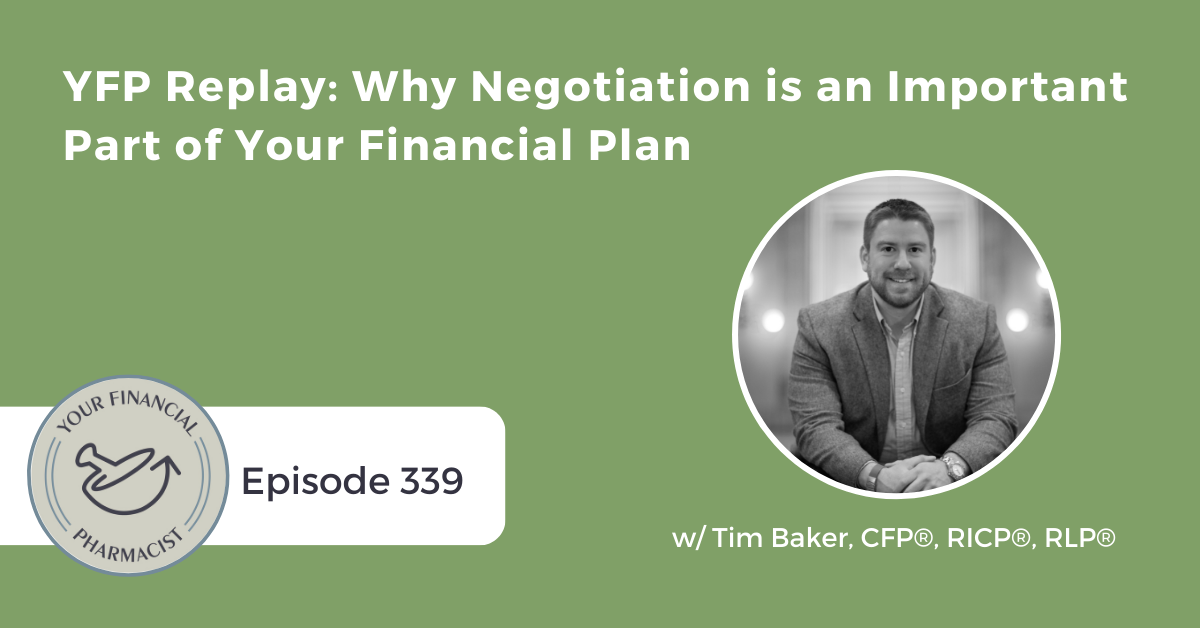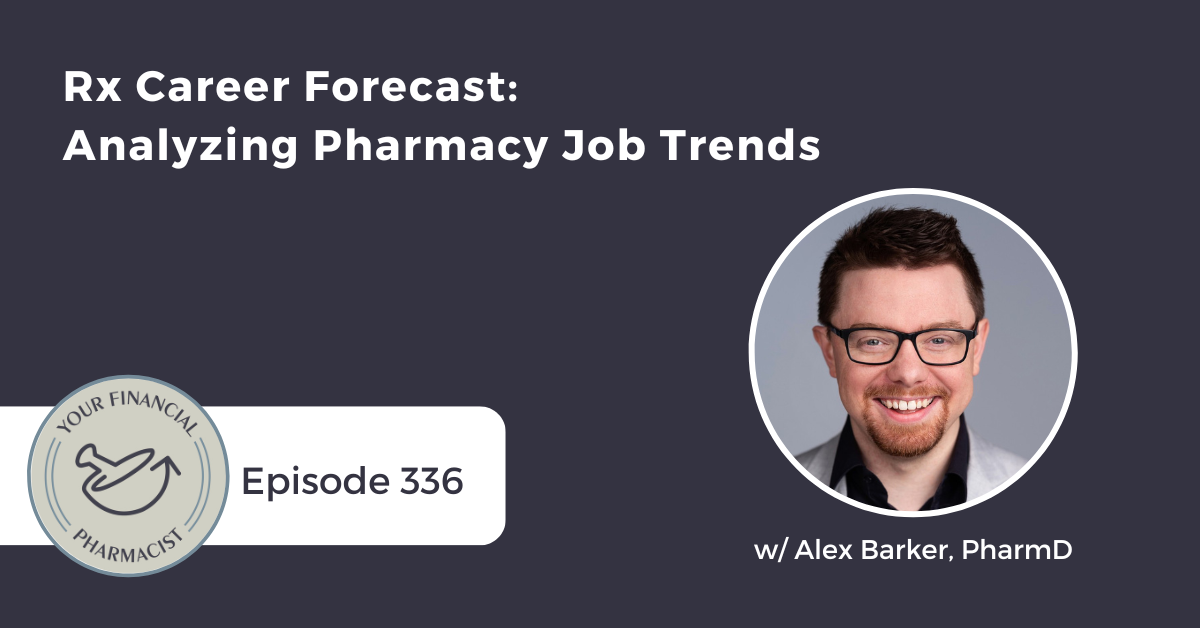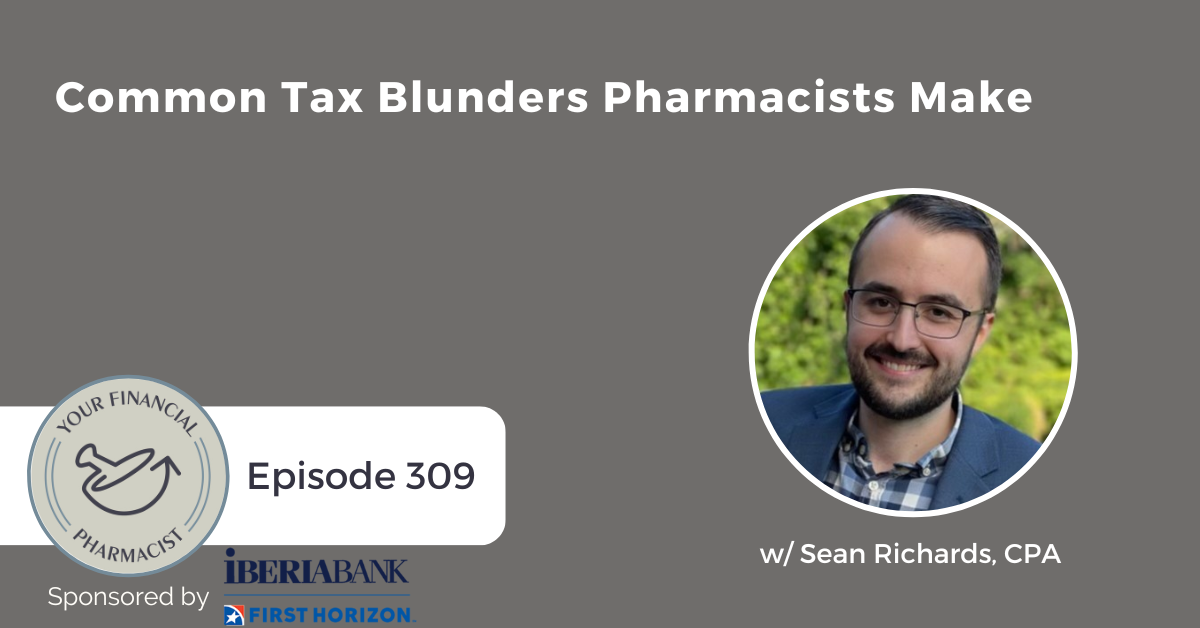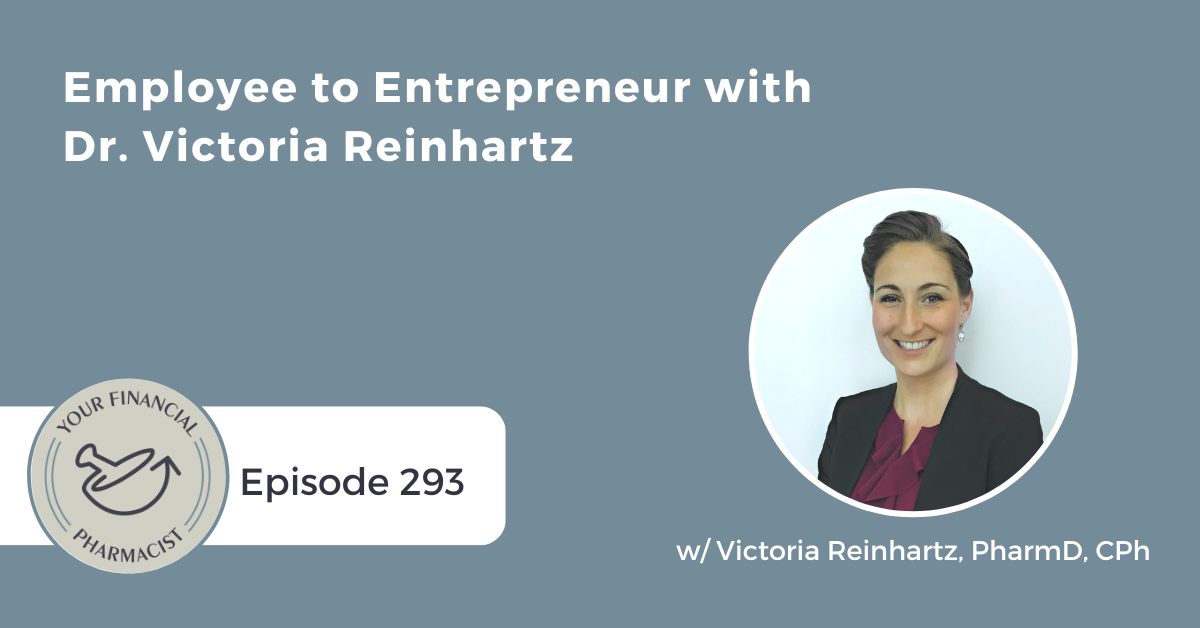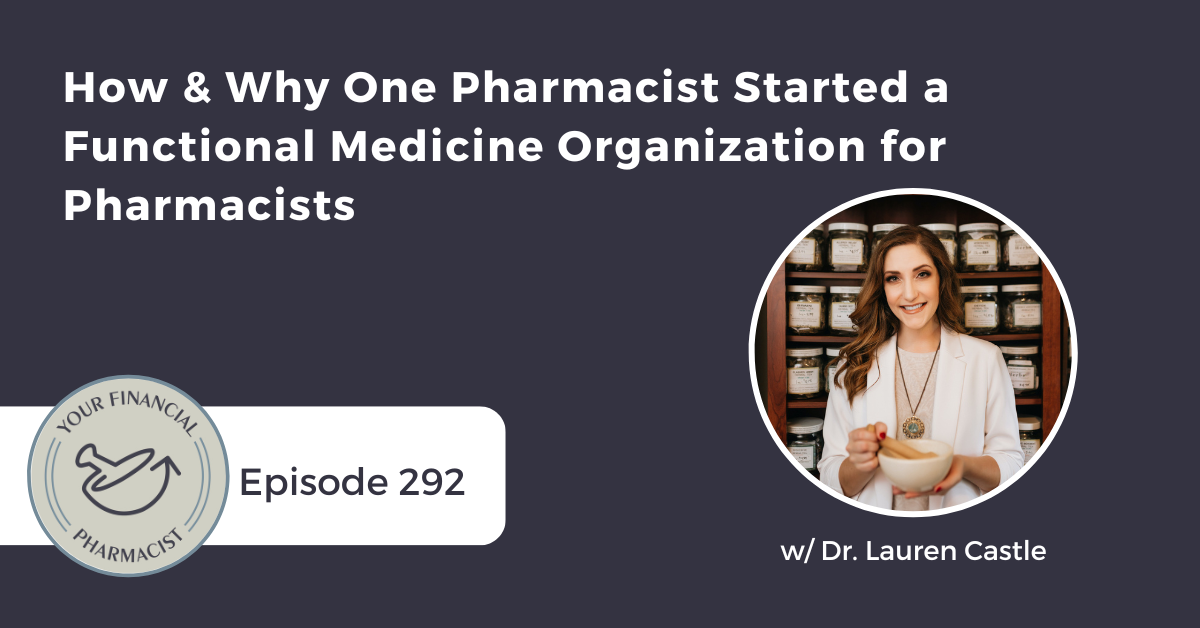In this episode, Tim Ulbrich, YFP CEO looks at three powerful areas for growing your income: maximizing your compensation, real estate investing, and building side hustles or businesses.
Episode Summary
While cutting expenses is a key part of managing your finances, there’s a limit to how much you can cut. The good news? Your income has no ceiling.
In this episode, Tim Ulbrich, YFP CEO looks at three powerful areas for growing your income: maximizing your compensation, real estate investing, and building side hustles or businesses. Tim shares some personal experiences and examples from other pharmacists who have successfully diversified their income streams and created financial opportunities that go beyond the traditional 9-to-5 grind.
Key Points from the Episode
- [00:00] Introduction to Financial Freedom
- [00:50] The Importance of Growing Your Income
- [05:01] Maximizing Your Compensation
- [09:12] Real Estate Investing
- [13:50] Side Hustles and Business Income
- [26:06] Leveraging Extra Income for Wealth Building
- [28:20] Reflection and Conclusion
Episode Highlights
“ Opportunities exist all around us to grow our income. I didn’t say that it was easy and I didn’t say it wouldn’t come without failures along the way. I said that there were opportunities all around us. And that it has no limits.” – Tim Ulbrich [1:43]
“ Is my value being compensated appropriately? If so, great. If not, are you advocating for yourself? And if you’re not advocating for yourself, why not?” – Tim Ulbrich [5:25]
“ Not all side hustles and not all businesses are a good return on time investment, and especially in the case of a business, yes, there is more upside than a traditional W 2. But there’s also risk and we have to assess what that risk is.” – Tim Ulbrich [14:46]
“ Real wealth building potential happens when you take income from these streams and have that money growing and working for you.” – Tim Ulbrich [27:12]
Links Mentioned in Today’s Episode
- YFP 126: Going Beyond Six Figures Through Medical Writing
- YFP 259: Building a Medical Writing Business with Megan Freeland
- YFP 171: How Austin Successfully Made the Financial Transition to New Practitioner Life
- YFP 280: How and Why This Pharmacist Pivoted to a Writing Career
- YFP 384: Beyond Salary: Negotiating Your Value in the Workplace
- YFP Real Estate Investing 46: Building a Family Business Around Motel Hacking
- YFP 362: Fatherhood, Family, and FIRE with Author Cory Jenks, PharmD
- YFP 359: Pharmacy Innovators with Jamie Wilkey, PharmD
- YFP 089: From Unemployed to Successful Pharmapreneur
- YFP 287: Monetizing Your Clinical Expertsie with Dr. Timothy Gauthier
- YFP 344: Beyond the ER: The Entrepreneurial Journey of Dr. Jimmy Pruitt
- YFP 217: How Kelley Used Her Clinical Expertise to Build a Business
- YFP 112: Why One PhD Pharmacist is Taking on Two Side Hustles
- YFP 379: Inspiring Bold Ideas: Career and Entrepreneurial Insights with Dr. Brooke Griffin
- YFP 180: How Allyson Used Her Pharmacy Skills to Build a Natural Skincare Company (started as a side hustle out of her house when working as a pharmacy admin at hospital)
- YFP 289: Building Pricklee with Pharmacy Entrepreneur Kun Yang
- YFP 243: A Non-Traditional Pharmacy Path from Pharmacist to Software Engineer to Entrepreneur
- YFP YouTube Channel
- YFP Book a Discovery Call
- YFP Disclaimer
- Subscribe to the YFP Newsletter
- Tim Ulbrich on LinkedIn
- Tim Baker on LinkedIn
- YFP on Instagram
- YFP Facebook Group
Episode Transcript
Tim Ulbrich: [00:00:00] Hey, everybody, Tim Ulbrich here. And welcome to this week’s episode of the YFP podcast, where we strive to inspire and encourage you on your path towards achieving financial freedom. Today, I’m diving deep into a fun topic for anyone looking to build wealth. And that is the role of growing your income.
While cutting expenses is a key part of managing your finances. There’s a limit to how much you can cut the good news. Income has no ceiling. In this episode, we’re going to look at three powerful areas for growing your income, maximizing your compensation, real estate, investing, and building a side hustle or business.
I’ll share some personal experiences and examples from other pharmacists who have successfully diversified their income streams and created financial opportunities that go beyond the traditional nine to five. So let’s dive in to this week’s episode.
Hey guys, welcome to this week’s episode. I’m excited to jump in. As we talk about how your income just might be [00:01:00] the rate limiting step of your financial plan. When we talk about achieving our longterm financial goals, whether that’s building wealth, having more funds to invest in experiences. Whether that’s giving all of the above, it comes down to having cashflow to achieve those goals and cutting expenses.
We’ve talked about that many times on this show before it plays an important role, make no mistake, but at some point in time. You can only cut so much. And so we want to spend some time looking at the other side of the coin, which is growing your income and what potential that might provide when it comes to the financial plan.
So what if we shifted our focus more to the income side of the equation? Because opportunities exist all around us to grow our income. I didn’t say that it was easy and I didn’t say it wouldn’t come without failures along the way. I said that there were opportunities all around us. And that it has no limits.
And this is a big mindset shift [00:02:00] for many of us. That grew up in a profession where there was a ceiling, at least one that we put in our own minds on how much we would earn with the degree that we had. Many of us went through school and we came out with this story. I’m set or unsaid that, Hey, when you graduate, you’re going to make a good six figure income.
And objectively speaking, pharmacists do make a good six figure income. But because of that mindset, we often get uncomfortable. If we think about income growing beyond that number. The idea that it could be more, maybe double or triple that. It’s scary because it butts up against what we have known and what we have believed, right?
It butts up against our experiences. Now, my experience tells me. In my own situation and working with many other pharmacists that if we have a solid financial base and foundation to work from, the more opportunities that we actually start to see, [00:03:00] perhaps they’ve been there all along, but the more aware we are, because we’re now in a position and a mindset that we can entertain the idea of taking calculated risks.
Because when we have that strong foundation, we shift our mindset from a scarcity mindset to an abundance mindset. And we begin to see the opportunities for how we can not only grow our income, but how we can leverage that income growth to other parts of the financial plan. So the question is what opportunities exist?
To earn more income. Tell me more, Tim, what opportunities exist to earn more income. And I’ll speak from experience of those that I have, uh, have run across my own financial plan and those that I’ve come across in interviewing other pharmacists on this show, certainly it’s not meant to be an all inclusive list.
And if you have other ideas, whether you’re employing them in your own financial plan, or, you know, of others. That are leveraging strategies to grow their income and expand their income to accelerate their financial plan. [00:04:00] Send us an email at info at your financial pharmacist. com. We’d love to hear about it and be able to address those on an upcoming episode.
Now, before we jump in, I am not going to spend time on the one income growing idea that perhaps is the most obvious, right? Which is picking up. One of the blessings that we have in our profession is that we can, in many cases, pick up extra shifts, either at our employer or at another employer, at a really good hourly wage, that those additional dollars could be put to work in the financial plan.
So, if that’s available to you, and you’re interested in doing that work, that just might be the path of lease resistance. So I’m not going to focus on that, but I am going to focus on three other buckets of which I can, I think you can grow your income, maximizing your compensation, real estate, investing, and generating income through a side hustle or a business.
And again, I’ll feature several examples of [00:05:00] pharmacists all along the way. So let’s start with number one, which is your compensation. Right. Let’s address what you already have available to you to see if we can maximize that further. See if we can squeeze out more from our compensation while we also explore other strategies.
So if you are working a W 2 job, I want you to ask yourself this question. Is my value being compensated appropriately? Is my value being compensated appropriately? If so, great. If not Are you advocating for yourself? And if you’re not advocating for yourself, why not? Is there a potential for a raise within your organization and negotiating that raise or perhaps a, a new position externally that could give a boost to your income?
And now we all know from experience that when it comes to satisfaction in the workplace, it’s not just about the income. So I don’t want you to lose sight of those other factors, but if your value is not compensated appropriately, is there an [00:06:00] opportunity internally or externally? That we could pursue to grow that top number.
Now, my experience tells me that making a transition from one employer to another is a good opportunity. It’s a good time to right size compensation and negotiate. If you have the leverage to do so now, of course, if there’s an opportunity within an organization, and that is one that you already like working for that organization, we want to pursue that first, but if not, perhaps a transition.
Can afford us an opportunity to grow our income. Let me give you an example. In 2018, I made the transition from an academic role at Northeast Ohio medical university to one at Ohio state. In addition to having my partner, Tim Baker, certified financial planner in my corner, who’s an expert in negotiation, and he was able to coach me through that process.
In addition to that resource, there was one thing in particular. That allowed me to jump [00:07:00] my compensation by more than 30, 000 per year during the transition. And that one key ingredient that I believe is a really important ingredient when it comes to negotiation is that I had leverage. Now that’s not a bad word.
That’s not a greedy word. It’s a fact when you look at the negotiation process, do you have leverage or do you not have leverage? It’s an important self assessment. And the reason I had leverage is that I didn’t have an urgency. To make that move. And I applied for the position with a mindset that, Hey, if it works out great, if it doesn’t, that’s okay too.
And that really led me to approach the interview with an abundance mindset. I was able to cast a bold vision for the position that I was interviewing for. And I was able to do that, knowing that that vision was either going to be a home run, or it was going to be a strikeout. And because I love the work that I was doing at Northeast Ohio Medical University.
I like my colleagues. I was [00:08:00] afforded great opportunities there. I was curious about this new position, but it wasn’t a must have. And that leverage really helped me throughout the negotiation process. So back to the question, whether it’s an internal negotiation or an external negotiation, is your value being compensated appropriately?
Yes. Ideally your income is outpatient inflation, but asking for a raise for inflation sake, isn’t going to get you very far in the longterm. Rather, we need to focus on value, value that you bring to the employer and ensuring that that value is fairly compensated. And the key word here in the negotiation is fair.
If we’re talking about value and fair compensation, we’re now in an environment that allow us for hopefully a successful. Negotiation. If you’re curious to learn more about negotiation strategies, Tim Baker, and I talked about this several times in the podcast, but most recently on episode three 84, where we talked about beyond [00:09:00] salary negotiation, looking at your value in the workplace, so make sure to check out.
That episode that’s area number one, as we look at how we can potentially grow our income. And there we’re talking about compensation. Area number two is real estate investing, real estate investing. Now, outside of investing in the purchase of our office building for your financial pharmacist and doing some more passive hard money lending.
I’ll talk about that more here in a moment. I don’t necessarily consider myself to be a big real estate investor. It’s an area that I value as a diversified part of the financial plan. It’s one that I want to continue to grow as a part of our own financial plan, but I don’t consider myself a big real estate investor or pro in this area, but we have some great resources available through our community.
And those have been led by David Bright and Nate Hedrick, who are the co hosts of the YFP Real Estate Investing Podcast. They put out some great content sharing, not only their own investing journeys, but also [00:10:00] featuring other pharmacists that are doing real estate investing in all different types of way across the country.
So make sure to check out that resource. That said. While I don’t consider myself to be a big real estate investor, I do personally know many pharmacists in our community that have been successful in this space and they’ve done it in a lot of different ways. And one of the cool things about real estate is that it comes in many different forms and flavors that depending on your risk tolerance, depending, uh, depending on what level of involvement, how hands on you do or don’t want to be, some opportunities may be more interesting than others.
And many of you are likely already real estate investors and perhaps aren’t even aware of it. I’m talking about investing in REITs, what are known as real estate investment trust, which just might already be in your asset allocation inside of your 401k or inside of your 403b as one example. And what is a REIT?
Well, instead of owning and holding a property, a REIT or a real estate investment trust [00:11:00] is an investment in a company that pools money together to own or finance a real estate portfolio. So it’s one way that you can diversify your portfolio and get invested in real estate without owning the physical property and managing that yourself.
So what are the different types of real estate investing that are out there? Probably what comes to mind for many people, what I consider kind of the traditional real estate investing approach is what I call a buy and hold. So you buy a property, perhaps it’s, it’s undervalued. Maybe you do a little bit of fix up for the property.
Hopefully you have a long term tenant. If not, you’re dealing with vacancy and turnover and you’re, you’re charging a monthly rent that that’s. Ideally, positive cash flow and you have that for a long period of time and you can replicate that process potentially over and over again. So that, that’s a more traditional, a more active approach, depending on if you have a property manager, if you’re doing it yourself, that would be a buy and hold.
But there’s lots of other ways. There’s short and midterm rental. So think Airbnb. Right. There’s fix [00:12:00] and flips think, uh, HGTV fixer upper. So these are properties where again, uh, a property that often might be undervalued need significant repair work. You buy it at that lower rate, you fix it up. And ideally you set, you sell it for a profit.
There’s many other considerations to be thinking about there, but that that’s essentially the idea. There’s things that are more passive, like syndications and hard money lending, where you’re serving essentially as being the bank for other people that are doing. Real estate investing. There’s commercial real estate investing.
There’s house hacking where you’re living in a property while renting out a portion of the property to one or more individuals. Heck you can even buy a motel Schitt’s Creek style and turn that into an investment property, similar to what Stewart and Elizabeth only did as they shared on episode. 46 of the YFP real estate investing podcast.
We’ll link to that episode in the show notes. So there’s lots of different flavors of real estate investing, and it’s certainly not for everyone, but it can [00:13:00] provide some very tangible benefits. Including rental income or cashflow appreciation of that property over time where that equity could be leveraged There’s tax benefits and certainly for those that are thinking potentially something like an early retirement We can liquidate some of these properties as one avenue of creating some of that cash flow before we pull on other Investment accounts that might be tied up to that 59 and a half age that we think about with things like a 401k or an IRA.
Lots to think about there. Make sure you check out a real estate investment investment podcast shows. If you’re not already familiar with those, and I think you’ll find those inspiring, informational, and just give you ideas of how real estate investing may or may not fit in with your financial plan. So that’s number two, is we look at three different categories of how you can potentially grow your income.
The third one that I want to talk about. Is side hustle or business income. Now, these are very different, right? If someone owns a business and they operate a [00:14:00] business and that’s, that’s their full time thing versus side hustle. When we think about traditionally, you’re working a full time or part time job in addition to doing the side hustle.
But because many side hustles can become a business, I’m going to group these two things. Uh, together now, I think it’s important to know, right? There’s, there’s risk in lots of the different things that we’re talking about more so with the business and the side hustle, but because side hustles and entrepreneurship have become all the rage over the last decade or so, and, and I’m, I’m all in for a good side hustle or a business, but not all side hustles and not all businesses are a good return on time investment, and especially in the case of a business, yes, there is more upside than a traditional W 2.
But there’s also risk and we have to assess what that risk is. And when it comes to growing your income through a side hustle or business, this could be pharmacy related, or as you’ll see with a couple of examples, as I get towards the end, it might be not pharmacy related, especially if you have a creative outlet or hobby or [00:15:00] skill that is independent of your role or skills as a pharmacist.
So let’s look at a few examples of pharmacists. That have experience building a side hustle or a business. And I’m going to group these into different categories just to get the ideas flowing as you think about your own financial plan, the number one category and no particular order is medical writing.
I see a lot of pharmacists that are interested in doing medical writing. Yes. You can be a contractor. To do medical writing so this could be a side hustle or you could build and own your own medical writing business So I think about individuals like britney hoffman eubanks who we had on episode 126 that has her own medical writing business banner medical I think about megan freeland who was on episode 259 where we talked about building her medical writing business while she was also working Full time job.
I think about Austin Ulrich who was on the podcast who talked about Going on his own as an as an entrepreneur to build a a medical writing business and how he’s able to do that
I think [00:16:00] about Warda Nawaz who talked about in episode 280, how she was able to pivot to a writing career. Lots of cool examples of pharmacists that are dabbling in this from a side hustle as a contractor to building their own medical writing business. Another bucket I would consider here is clinical consulting, right?
In days gone by, this would be performing things like medication therapy management services for a local pharmacy or independent pharmacy in modern day. This would be doing things like virtual medication therapy management or comprehensive medication reviews through companies like Aspen RX Health. So there are opportunities to pick up extra hours, earn some additional income, applying skills that maybe you’re using in your everyday job, or perhaps is tapping into a different part that you’re not using.
Every day in your work, there’s opportunities in speaking lots of pharmacists. I know that are getting paid for speaking Now this can be a grind when you think about the travel if it’s in person speaking Um, sometimes the the money may not be as [00:17:00] as good as it you want Depending on what type of speaking you’re doing, what your audience is.
I know several pharmacists that have made additional income predominantly as a side hustle, this certainly could build into a career. One I think about in particular would be Corey Jenks. We’ve had on the podcast most recently on episode three 62, uh, talking about fatherhood, family, and fire. If you’re not familiar with Corey, he’s written a couple of books and.
On that episode, we got to talk about his book on fatherhood. He’s a comedian and he just has a great speaking package and keynote that brings his healthcare experience, formerly working with the VA now working for a different employer, but. Pairing that health care experience with his passion and love for comedy and bringing that in a way that helps Clinicians pharmacists and other health care professionals be more compassionate And light hearted and how they approach those interactions with patients and he gets paid For the speaking that he does and his book led to his speaking his speaking helped further his book sales So [00:18:00] that’s one example that I would throw out there The next bucket that I would bring forward is what I’m calling content creation or online courses or communities where people are monetizing their clinical expertise.
So they built a brand, they have an area of clinical specialty and expertise, and they’ve been able to monetize that in different ways. Several individuals here. That are worth highlighting one, Jamie Wilkie. We had her on, on a couple episodes of the podcast, most recently on three 59. Again, we’ll link to all these in the show notes.
She first built a pharmacogenetics, uh, course in community. She worked for a while in retail pharmacy, left that work, built her own, uh, course and community has now built a brand under the misfit farm D where she’s helping to. coach pharmacists that are looking at career transitions and how they can take the skills that they have and be able to apply those skills to perhaps a different work scenario and employment setting than the one that they’re in now.
So if you’re not already following her on LinkedIn, I would, I would encourage you to [00:19:00] check her out. She’s got great content. I think about individuals like Blair Teelmeyer. Who built the pharmapreneur Academy. And she took a difficult situation of finding herself unemployed to starting her own business and became really a thought leader in our profession, not only through that Academy, but through her personal brand, that is a lead to additional consulting opportunities for her as well.
She wrote a book as well, early in her journey. Uh, so, so lots of pieces to consider here. I think about Tim Gauthier, who’s an ID clinical specialist that we had on the podcast a couple of years ago, who has built. His has taken his clinical expertise to build and monetize, uh, an online community and paid courses.
He has a social following that he built early on in Twitter and now X all focused around ID stewardship. So it’s a work that he’s doing day in and day out, and he’s able to then package that and build a brand around being the leading expert in ID stewardship for pharmacists. I think about individuals like Jimmy Pruitt, [00:20:00] who’s worked full time in an ED pharmacy and has built, started with a podcast.
He’s got an online community and resource. He’s got now an in person, uh, live event for emergency pharmacists and other healthcare professionals. Uh, built that while working full time as an emergency clinical specialist. Again, taking the work that’s being done every day and using it to monetize that clinical expertise and be able to reach a broader group.
I also think about individuals like Kelly Carlstrom, the founder of Kelly C Farm D, who’s a PGY 2 trained oncology he monk specialist that said, Hey, why isn’t this information more readily available outside of large academic medical centers and PGY 2 trained programs? And clinical specialists. And so she built an online community and resources where pharmacists all over the country could have access to that type of information to grow their clinical skills so they could better serve their practice sites and their patients.
Lots of cool examples of pharmacists that are creating courses, communities, [00:21:00] content, finding monetize their clinical expertise. Another bucket would be being an adjunct professor or teacher. I know several pharmacists that work full time but then they adjunct teach at a, could be a college of pharmacy, could be a college of medicine, uh, could be with a nursing program, could be with another healthcare profession that has a pharmacology course, could be in person, could be virtual, online courses, lots of different ways to get involved and to be able to again tap into a different area of your skills.
And earn some additional income. Another area would be an expert witness in episode 112 of the podcast A phd trained pharmacist brent roland shared his story about becoming a pharmacy expert witness for law firms Primarily focusing on marketing cases in addition to standard of care cases And he was able to get this experience while he was in school with his professor Asking for help on a big case.
That’s where he got started and then he continued to receive Casework from there. Many criminal [00:22:00] and civil cases involve medications, involve toxicology, involve quality of care and negligence. All areas where pharmacists are positioned well to provide their expert, uh, opinion and, uh, potentially some expert witness and testimony.
Another area would be consulting. Lots of pharmacists that are doing consulting. I think about individuals like Jill Pallier, who has a background in patient safety, uh, who’s built a specialty practice and has really paired those skills to be able to build a consulting business. I think about individuals like Brooke Griffin, who we had on episode 379 of the podcast, where she talked about her journey, building the business, the bold idea group.
Where she’s a full time academician at Midwestern and was able to build this coaching business while she was and continues to work full time in academia. I think of another category, which would be software or app based businesses. So Derek Borkowski who built pearls, if you’re not already familiar with pearls, I hope you’ll check it out.
[00:23:00] Great drug information resource. When I was in pharmacy school, we had a very antiquated version of micrometics and Lexicom. This is a much more user friendly modern version of those tools. I often joke with Derek, I wish I had this tool and resource available to me when I was in pharmacy school and residency.
And we had Derek on episode 243 where he talked about his non traditional career path, going from a community pharmacy to becoming a software engineer, and then ultimately building his business at Pearls. Other software app based business, I think about PharmaSol and Natalie Parker, graduate of Ohio State, who built PharmaSol with her co founder from MIT.
And PharmaSol is a company that streamlines pharmacy communications with advanced AI. And helps to automate calls and messages with patients, providers, and payers. Really cool example of someone that took their interest with AI and technology and paired it with their background in pharmacy. Another category I think about would be developing a physical product based business.
Now this can come with high risk and [00:24:00] high reward, right? There often is some, some higher, uh, equipment and costs to get started when you talk about a product based business, but two in particular stand out for me, one that’s pharmacy related, one non pharmacy related. One would be Alison Brennan, who we had on episode 180 of the podcast, where we talked about her journey, where she used her pharmacy skills to start her skincare company called Emma Gene Co.
And she started the skincare company out of her house while she was working full time and then eventually part time as a hospital administrator. Eventually she left that work to work full time on the skincare business. Now has her own team, has a warehouse, business is doing really well. Really cool example of a product based business.
The other one I think about here would be Prickly. Prickly is a cactus, uh, base, uh, beverage company. And a shout out to Quan Yang and his team and his co founder Mo who have built Prickly. We had Quan on episode 289, talking about how they built that. What was the vision behind it? Why did they do it? Uh, [00:25:00] really cool example of a pharmacist that appeared on Shark Tank and was able to leverage their entrepreneurial interest to build a product, uh, in what is a very competitive market, right?
The beverage industry. And last, but certainly not least, I think about some of the non pharmacy Uh entrepreneurs that are out there or the side hustlers that are out there as well Individuals like landon connor who’s a pharmacist who has a passion for photography and has built a successful photography business I think about pharmacist stephanie roberts who built an apothecary art business.
I think about pharmacist rosie chun who built a calligraphy Artist business successful business out in California that does a lot of events and high end calligraphy work for celebrities and Corporations again several different ways. There is no one right way, right? The purpose of me sharing these was to give you some examples and hopefully spark some creativity ideas of pharmacists That yes many of who have stayed in their pharmacy careers But are also building some really [00:26:00] cool things on the side or eventually some of those Were were evolved into a business
now here’s the kicker when it comes to earning additional income, whatever avenue that might be, whether it’s growing our compensation, perhaps generating income through real estate investing, whether passive or active or generating income through a side hustle or business that extra income while it’s nice, and we can apply it towards certain goal, that extra income itself.
Is not where the real wealth building potential happens, right? Let me give you an example. If, if you were to take an extra 10, 000 that you earn and you apply it towards a, let’s just say a student loan debt payment, that’s at 6%, and there’s certainly a time and place for that. So don’t, don’t mishear me on this, but in that instance.
The value of that extra 10, 000 is limited, although valuable, limited to paying down that debt by 10, 000 and any of the interest that we would save that would have otherwise accumulated, but over time is we’re able to build a [00:27:00] strong financial foundation. If we can turn that extra income into assets that will produce further income and hopefully do so at a rate that compounds over time, that’s where we really start to see the money.
Working for us. Real wealth building potential happens when you take income from these streams and have that money growing and working for you. So what does that look like? Again, lots of ways that you can do this, but for me, it has included turning extra income from different sources into more traditional compounding assets, right?
Like equities inside of a 401k or four or three B IRA, HRA, HSA, taking that income and investing it as a hard money lender for others that are doing real estate investing, taking that extra income and purchasing a cash flowing. Appreciating property, taking that income and building equity and another business.
taking that income and investing in other businesses and taking [00:28:00] that income and growing an existing business, therefore increasing the value or the equity of that business over time. Those examples I think are really where you start to see the flywheel of how that income and taking off the ceiling of your income, how that income can be leveraged.
Towards that longer term plan to building wealth. So as we wrap up, let me leave you with a few questions of reflection. As you think about how to apply this in your own financial plan. Number one, do you believe that the income that you have and your potential of income for the most part is fixed? If so, why is that the case?
Where does that mindset come from? I think it’s really important to explore that. Second question. If you work for a traditional W 2 job, are you being compensated fairly for the value that you’re bringing? If not, what has been holding you back from asking and negotiating additional compensation? And number three, what opportunities [00:29:00] are there for building wealth?
Investing in experiences and giving beyond those that I mentioned throughout this episode. And if you have an idea, as I mentioned at the beginning of something you’re doing or something, you know, someone else is doing, send us an email at info. At your financial pharmacist. com. Thank you so much for listening to this week’s episode of the podcast.
If you like what you heard, do us a favor, leave us a rating and review on Apple podcasts, which will help other pharmacists find the show. And finally, an important reminder that the content in the podcast is provided for informational purposes only, and is not intended to provide and should not be relying on for investment or any other advice for more information on this.
You can visit your financial pharmacist. com forward slash disclaimer. Thanks so much for listening. Have a great rest of your week.
[END]
Current Student Loan Refinance Offers
Note: Referral fees from affiliate links in this table are sent to the non-profit YFP Gives. | Bonus | Starting Rates | About | YFP Gives accepts advertising compensation from companies that appear on this site, which impacts the location and order in which brands (and/or their products) are presented, and also impacts the score that is assigned to it. Company lists on this page DO NOT imply endorsement. We do not feature all providers on the market. |
$750* Loans ≥150K = $750* ≥50K-150k = $300 | Fixed: 4.89%+ APR (with autopay) | A marketplace that compares multiple lenders that are credit unions and local banks | ||
$500* Loans ≥50K = $500 | Variable: 4.99%+ (with autopay)* Fixed: 4.96%+ (with autopay)** Read rates and terms at SplashFinancial.com | Splash is a marketplace with loans available from an exclusive network of credit unions and banks as well as U-Fi, Laurenl Road, and PenFed |
Recent Posts
[pt_view id=”f651872qnv”]

